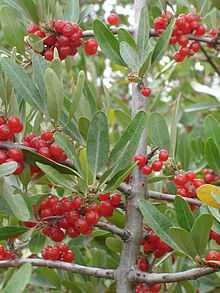Elaeagnaceae
From Wikipedia, the free encyclopedia
| Elaeagnaceae | |
|---|---|
 | |
| Scientific classification | |
| Kingdom: | Plantae |
| (unranked): | Angiosperms |
| (unranked): | Eudicots |
| (unranked): | Rosids |
| Order: | Rosales |
| Family: | Elaeagnaceae Juss.[1] |
| Genera | |
 | |
Elaeagnaceae, the oleaster family, is a plant family of the order Rosales comprising small trees and shrubs, native to temperate regions of the Northern Hemisphere, south into tropical Asia and Australia. The family has 45-50 species in three genera.
They are commonly thorny, with simple leaves often coated with tiny scales or hairs. Most of the species are xerophytes (found in dry habitats); several are also halophytes, tolerating high levels of soil salinity.
The Elaeagnaceae often harbor nitrogen-fixing actinomycetes of the genus Frankia in their roots, making them useful for soil reclamation.[2] This characteristic, together with their production of plentiful seeds, often results in Eleagnaceae being viewed as weeds.
References
- ↑ Angiosperm Phylogeny Group (2009). "An update of the Angiosperm Phylogeny Group classification for the orders and families of flowering plants: APG III" (PDF). Botanical Journal of the Linnean Society 161 (2): 105–121. doi:10.1111/j.1095-8339.2009.00996.x. Retrieved 2013-07-06.
- ↑ http://www.winrock.org/fnrm/factnet/factpub/FACTSH/Elaeagnus.html
External links
This article is issued from Wikipedia. The text is available under the Creative Commons Attribution/Share Alike; additional terms may apply for the media files.